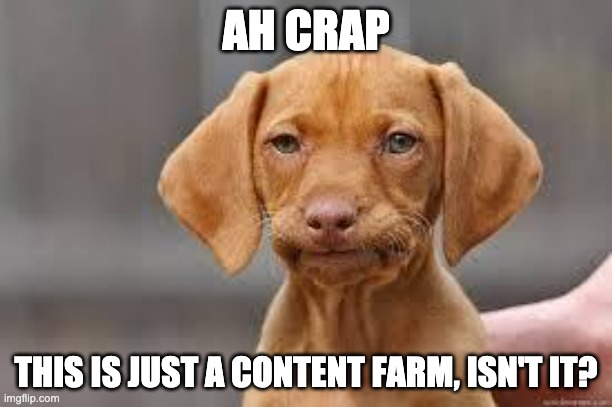I got my very first side gig through a friend who was churning out something like a hundred articles for a website owner and needed help finishing the project. How thrilled was I to be a legit freelance writer?
So imagine my disappointment upon sharing my first piece with my fellow writer friend – if memory serves it was about buying designer handbags – and he basically indicated I was wasting my fine prose; all I had to do was write repetitive copy that included the words “Pucci” and “Prada” and “handbag” over and over. “No one’s actually gonna read these,” he assured me.
Cue palm to forehead. I was writing for a content farm, generating bait for Google’s 2003-era search algorithms.
Thankfully, things have changed since those internet days of yore.
SEO requires a strategic approach
For one thing, SEO really should underpin your content strategy.
Once about stuffing your content with keywords, SEO is now about planning and developing meaningful content that helps your audience solve problems and/or meet goals.
That’s not to say keywords aren’t still important.
It’s just that as the quality and authenticity of content has taken center stage, the most effective ways to use keywords have changed (more on that in a bit).
Google algorithms have evolved
In the spirit of its corporate mission “to organize the world’s information and make it universally accessible and useful,” Google continuously updates its search algorithms to weed out low-value webpages and elevate the most useful content to the top of its search engine results pages (SERPs).
Of course, most B2B companies are not actively burying pages of keyword-bloated content on their websites in an outdated attempt to secure high rankings.
But at the same time, it’s easy enough to get so busy with the day-to-day that SEO becomes an afterthought – just sprinkle a few keywords throughout your article and bada bing, we’re good, right?
Really, a bunch of things go into a good SEO content strategy, and each could have its own dedicated guide. We’re going to give you the TLDR version here – we’ll touch on developing content preferred by Google search result algorithms and modern web users, on-page optimization techniques, technical SEO pointers and the tools that can make SEO life a little easier.
You won’t get overnight results: SEO growth takes time
Growing SEO is like, well, growing pretty much anything – it takes time and effort to see results. If you’ve ever cultivated a vegetable garden, you know you can’t just throw seeds in the ground in the spring and expect a bountiful harvest in a few months.
Same with SEO – it’s primarily a top-of-the-funnel strategy, working to attract new leads to nurture with CTAs (calls to action) for gated content like ebooks, reports and white papers.
SEO needs ongoing attention
You should consistently be feeding your site with new content. Refresh existing content for ongoing relevance and searchability, and leverage external SEO methods like publicizing new pieces or using social media to promote awareness.
Investing time on the backend to produce strategic, high-quality content may not yield instantaneous success. But long-term, you’ll cultivate some juicy SEO fruit. A well-optimized piece of content can grow traffic for months or even years, gaining more and more traffic (read: eyeballs) over time.
What about PPC advertising?
One way to jumpstart traffic while you wait for organic growth is to invest in pay-per-click (PPC) advertising. With PPC, you pay for placement of an ad linking back to your website. The fee is based on the number of clicks on your ad (pay per click, get it?).
PPC can get you noticed faster in a crowded market and drive traffic from qualified leads. And you’ll be able to report at a granular level, so you’ll know exactly how it’s working. But it’s not a sustainable long-term strategy. Remember, you’re paying per click, so as your traffic increases (yay!), so does the cost (booo!).
PPC campaigns work well in scenarios where quick results are needed – when you’re just starting out, sure, but also for time-sensitive offers or to promote a specific piece of content, for example. Then, as your organic traffic and site credibility increases naturally, you can start to pull back on (or reallocate) your PPC budget.
A lot goes into planning and executing a PPC campaign; Hubspot does a great job of explaining the process.
Content is king – but you need to write for the people
In 2011, Google updated its search results ranking algorithm to penalize websites with low-quality content heavily laced with keywords. So, don’t do that.
Keep the Google E-A-T principle in mind
Google prioritizes content that embodies its EAT principle, which stands for expertise, authority and trustworthiness. EAT is a concept of Google’s Search Quality Guidelines, meaning that algorithm updates are based on EAT, and Google uses these criteria to evaluate the quality of web pages.
So it’s important to keep in mind for your SEO content strategy. Build your EAT cred with content that:
- Demonstrates that you know what your audience needs, and why you are knowledgeable in your industry (Case studies are a prime example here.)
- Shows why you stand out in your industry (Content that’s widely shared on social media and that’s linked to by websites is key to building authority.)
- Proves you’re trustworthy (Think reviews and testimonials, and don’t forget transparency – post your privacy policy and terms and conditions.)
Consider user intent
Write content in an authentic voice, aiming to provide useful information that fulfills search intent – the purpose behind a user’s search query. (Google has also evolved its algorithms to better identify search intent and to more highly rank websites with content that best matches intent.)
If this sounds complicated or intimidating, fear not. Creating content that will net these results comes down to knowing your target audience.
Build out content topics that focus on the web users you’re trying to attract, their needs, and how your unique knowledge can help them. As marketers, that’s kinda what we do anyway, right?
Identify core topics and keywords
Knowing the kind of information your audience needs is the first step. Discovering how and they search for it – we’re talking keywords here – comes next.
There are all sorts of keyword research methods and tools you can explore. For starters, you can run your own Google searches, beginning with a broad term and then narrowing down the focus to discover keyword variations and long-tail versions of the keyword.
Long-tail keywords are much more specific and (therefore more rare) search terms. This Search Engine Journal article explains why long-tail SEO strategy can get you higher rankings on SERPs and result in better conversion.
Another simple tactic is to check out pages that rank highly for the keywords you’ve identified as high priority – see what they’re doing, and model (but don’t copy) your content after best practices you identify.
Ramp up on-page optimization
On-page optimization is the practice of optimizing web pages for specific keywords to improve your position in search engine rankings (and ultimately grow your organic traffic).
On a high level, it’s about providing a great UX, with valuable, trustworthy content, and at the same time making it easier for search engines to interpret content relevance.
Here are some of the most essential things to do on a granular level to make that happen.
Optimize for one keyword at a time
One page, one target keyword. And although keyword stuffing is certainly out – after all, that makes for a crappy user experience – you still need to use that target keyword a few times throughout the page.
Importantly, it should show up in your headline and within the first 150 words of copy to signal relevance to that keyword search. And then sparingly throughout the rest of the content.
Identify related search terms and include them, too
For example, someone searching for “antique auto insurance policy” (your target keyword) might also search for “niche insurer” or “antique auto insurance broker near me.”
Weave these related search terms into your content as well.
URLs, title tags and meta description text
- URLs: Optimizing your URL structure is pretty easy, friends. Keep them short and include your target keyword.
- Title tags: The title tag – the clickable link to your website that appears in search engine results – signals the context of your page to search engines. It should include your focus keyword. It’s critical that the content on the page is relevant to your title tag.
- Meta descriptions: This is the text below your title tag, and it should also include the page’s target keyword. Concisely (in 160 characters or less) summarize what the reader will get out of visiting the page. You can include a CTA (but never be spammy). Meta descriptions also must be consistent with page content.
Support your SEO content strategy with these all-stars
So, as established: Anything you can do to build brand credibility through unique, user-focused content is insanely important.
Blogs and pillar pages are key content staples that not only help rank higher in search algorithms, but also work toward developing your brand as a trustworthy source of authoritative information.
Blogging. It’s no secret that a well-optimized blog is an MVP for content marketers. Ideally, a B2B blog is updated on a regular basis (e.g., bi-weekly, weekly, monthly).
Blogs can include a mix of how-to articles, listicles, tips and tricks, high-level opinion pieces, case studies to build trustworthiness, news about your company…the idea is to always, always be relevant and helpful.
Plan an editorial calendar to keep blog content on track, including topics built around the keyword searches you’ve identified.
Pillar pages. Pillar pages are the cornerstone of the topic cluster content strategy. Longer than a blog article (typically more than 2,000 words), they broadly cover a main topic relevant to your industry, serving as a hub linking out to related information on your site.
For example, an HR software company might have a pillar page that provides an overview on candidate experience, touching on what it is, why it’s important, best practices, current challenges, supporting technology, and other related subtopics. This main candidate experience page would then link out to blog content digging into these specific subtopics. As another example, here’s our pillar page on marketing automation.
Done right, pillar pages and content clusters are SEO rocket fuel.
Check out what the Content Marketing Institute has to say about topic clusters to learn more about this content strategy.
A note on PDFs: Beware that PDFs are not the most ideal format for boosting SEO performance for a few reasons. Most notably, PDFs typically lack the right metadata for optimal indexing by search engine bots, their formatting doesn’t play nice with SERPs, and links within PDFs aren’t processed the same way as on an HTML page. So, use sparingly. HTML content is always best.
Technical SEO best practices
Technical SEO has to do with the infrastructure of your website rather than the actual content. It’s a set of tactics that help search engines access, crawl, interpret and index your content accurately. Here’s what you should keep in mind:
- URL/site structure: Build your information architecture in a way that makes sense to a visitor, creating parent/child relationships between pages that should be reflected by slashes in your URL structure. For example, a page about hamsters might be nested: yoursite/pets/rodents/hamsters.com.
- Responsive mobile design: If your site isn’t optimized for display on mobile (think: cell phones and tablets), Google is going to ding you.
- Server response times: Make sure that your pages don’t take a thousand years to load. Use CDNs, reduce image sizes, and clean up messy code, because the faster a page loads, the more Google will like you.
- Redirects & broken links: When you kill a page that’s already been indexed, you need to properly redirect the link so that visitors using the old link don’t get a 404 error. Here’s a little more on redirects. Also, check your site on a regular basis for broken links (internal or external) and clean them up! A tool like Screaming Frog is one way to find them.
SSL certification: If your site doesn’t have an SSL cert, Google is going to warn visitors that you may be dangerous. No bueno. Here’s how to fix. - Cross-links and backlinks: Make sure that you’re being thoughtful and intentional in how you cross-link pages within your own site, providing visitors with a pathway to follow for more info. You’ll also want to earn backlinks to your site from other sites. The more high-quality sites out there pointing back to yours, the more Google will know that you’re relevant and high quality too. This is a long-tail project, but keep putting out great content and eventually you’ll start to gain links. You can also run an outreach campaign to other publications in your space, recommending pages that they can backlink to in order to give their readers more value.
- Image alt tags: While this is more about making sure your site is accessible to all visitors, including descriptive alt tags on your images can also help from an SEO standpoint by giving search engines a little insight into what’s in a graphic or photo on your page.
- Eliminate duplicate content: Google HATES duplicate content. Scrub your site to make sure that you don’t have any instances. If you do, either get rewriting or, if it can’t be avoided, set a rel=“canonical” tag to inform Google which page is the primary.
Even if you have great content, poor technical SEO decreases the chances of people actually seeing it. It’s a good idea to perform a site audit to identify areas that need improvement; a Google search will point you toward free checklists and audit tools ranging from basic to advanced.
Tools that boost your SEO strategy
Free tools abound to help you check and improve on-page SEO. There are keyword research and tracking tools, plug-ins that check your content for any potential issues, analytics tools that help you assess your rankings and identify areas for improvement. Some examples include:













